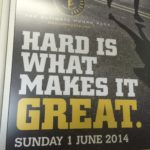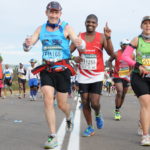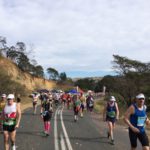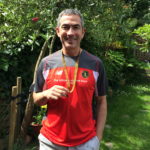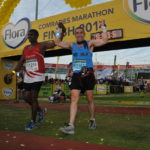Or How to run 56 miles aged 50.
To describe the entire run here would be tedium for the reader, so I will do my best to give an idea of the legend that is Comrades, in small bite size chunks.
The run:
Comrades has a number of famous landmarks, all of them hills or points of significance, usually meaning high points of pain or misery. Depending on which way you are running, up or down, you will pass through the famous and feared Polly Shortts, Inchanga, Bothas Hill, Drummond, Fields Hill, all landmarks that have broken many an athlete over the 90 year history. Comrades has over its 90 year history built up runners into absolute legends, landmarks have obtained feared almost mythical status, it may not be the longest or most intimidating ultra, but it is now one of the most iconic runs that still exist, attracting 18000 every year. The two most iconic parts are Arthur’s Seat: a plaque commemorating Comrades legend Arthur Newton which runners touch as they go past, then there is the Wall of Honour or Comrades Wall, a cut into the side of a bank covered in name plates for anyone who has completed Comrades. These all make one feel that you are truly a part of something special, part of history.
My experience of Comrades was less of the named hills and areas but more of the smaller details, some of which I remember, such as The stunning sun-rise over our left shoulders an hour into the race. Warm red and golden colours through the clouds. So uplifting. Especially the clouds. The temperature was expected to hit 28, which could spell trouble but the high cloud cover looked promising. The next surprise was the infamous chicken farm which hits you in the nostrils with such force you suspect all the runners ahead of you have forgotten their manners and not left the road to do their business. It’s a welcome and humorous distraction on what is a long, arduous journey. There are plenty of distractions on the route, ways to tick of each mile, to get you through the tedium of 90km, the best being the water stations every km or so where you grab sachets of water and Energade, cups of coke. These are welcome pit stops where we would walk, drink, replenish and begin again. Without planning our tactics, Isaac, my new friend, and I developed our own run/walk strategies, which basically involved running until the water station, walking, then running until the bottom of a hill, walking for a minute, then agreeing on a landmark ahead to run to, arguing about the exact landmark, one of which kept us going for a fair few miles: is that a tent or a gazebo. A question which remained unanswered.
We made sure we ran more than we walked, but there are certain sections which just invite walking, like steep inclines every few miles.
Lining the majority of the route are the amazing people who camp out every year to either greet, support their runners or just to sit all day enjoying this most famous of South African events. braais, beers are the order of the day along with the best treat ever, boiled new potatoes covered in salt. You don’t need to take any food with you, it will all be provided not just by the organisers, but also by the spectators. Fruit, nuts, chocolate, water and potatoes in salt.
Towards the latter part of the run, around 8 hours in and it is hot, this is when the angels with the hose pipes appear. Folk who stand outside their houses offering a spray of water as we trudge past, although I mad e sure I grabbed the hose and drenched myself.
There are sayings that I know get repeated year on year, and I heard it at least 30 times in the first 30 km, and it was, ” How is this a down run?” Technically it is as the last 30 km drop down significantly to sea level and Durban, but the first 60km are very up and down.
“How are you doing? “, is another frequently heard question, usually met with a grunt, or in my case, “still alive”
At one point my friend Isaac asked me “how do you eat an elephant”, from its tail I replied, but the answer to this conundrum became our mantra for the rest of our journey: “one bite at a time”
I’m sure all runners and non-runners alike have their own self-talk or mantras they use during times of difficulty, mine being “I’m light as air” and “one foot in front of the other”, but “one bite at a time” absolutely symbolised how we were running it and how we ought to tackle it when we frequently became overwhelmed by the remaining miles and task ahead. Try not to get too ahead of yourself, just take it one bite at a time. What this did for us was to keep our attention on the moment, to deal with our immediate needs, water, food, gels and let the distance take care of itself. We knew we were on track to come in under 11 hours so long as we kept to the plan, the wheels didn’t come off and we continued to eat the bloody elephant. I do believe that this unintentional mindful approach got us through some of the worst patches, where we struggled to keep running and wanted to walk more. This aspect is I believe inevitable, unless you are in the silver medal sub 7:30 brigade. In all other marathons I have done, to walk was never an option, unless it was a truly bad day at the office, but when it comes to ultra running, walking is part and parcel of the process, to replenish, recover in order to get the job done, as opposed to running flat out until the tank is empty and then hopefully crawl to the line.
Of all the advice handed out by anyone who had run Comrades before, most of it priceless, was one throw away line about the water stops: to grab some ice from the buckets and suck on it. These shards of frozen water became my little gems, slowly sucking the ice to cool myself down from the inside, a simple but so effective way to keep your engine running cooler. The only issue was having to stop and in some cases stoop down to grab the ice. But I was fine, no cramping and no sudden muscle spasms. The truth was I was fine. I was taking my gels every hour, I had also laced 3 of them with the magnesium Muscleze powder. I was drinking enough water, also taking a sip or two every hour of isotonic drink. This race wasn’t just a physical one, it is mental. Big time.
For me this race was 10k too long, at 79k I had had enough. I wasn’t injured or exhausted or cramping,I was just bored and couldn’t see the end coming. Isaac was calculating all the time what we had to do to get in under 11, basically keep doing what we were doing, for another 10 bloody km’s. The trick is to occupy the mind. Find ways to alleviate the tedium, talk, look at the scenery, be creative, mutter to yourself, meditate, or just put your head down, literally, and plod on. We were, by this time, choosing to run the downhill sections in 3-5 min chunks, walk for a minute, find the next target and head toward that. Any incline, and that means most of the thing, we walked up. Amazingly, each time Isaac checked his schedule, we were still on course, although our cushion had now evaporated to 3 minutes. We would still finish though. At one point I fell a few hundred meters behind Isaac as I grabbed some more ice to suck. He was gone, I couldn’t see him. So we were going to finish this separately, with 7 km’s to go I was having to decide whether to just walk the rest or soldier on. I saw an arm in the air ahead and attached to the arm was a familiar face, he was waiting, he needed to keep moving, but he clearly had no intention of leaving me behind. As I reached him I put my arm around his shoulders and said thank you, let’s go and finish the bloody race. We kept ourselves going by trying to be the first one to say I can see the sea….neither of us claimed it correctly.
The last 2k came into view as we came off the highway and into downtown Durban, barriers either side of the road holding back eager shoppers trying to do last minute market deals, occasionally a few escaped and crossed in front of us as we trudged on. The sun was setting as we moved closer to the end. I could see the stadium now. We passed a guy I had met at the race expo who had 8 COMRADES but today he was struggling, he waved us past. This gave me such a kick, that actually we were doing fine and feeling fine. With just 1km to go Isaac wanted to walk some more, we knew we were on for a sub 11 hour, but if knew we had to keep running now to the finish. I began my end of race ritual of goading the by now rather bored crowd into cheering for us, with shouts of Come On…..a few responded, but this got us ever closer to the end.
We are going to finish together I said to Isaac. The stadium was there and soon enough we were on the grass with only 200 meters to go. Jus then I saw lovely Annie and Brendan waving to me, this brought a huge beam to me and I grabbed Isaacs hand as we crossed the line, only this wasn’t the line but a footbridge over the course.
So rather embarrassingly I grabbed his hand again as we crossed the real line in 10:55. We had our Bronze medals.
After almost 11 hours of running and walking the hour or so following the run was somewhat underwhelming. I was anticipating a huge emotional experience as I crossed the line, tears galore, thoughts of home and family and everything that I had gone through to get me to this point. The combination of physical and mental exhaustion resulting in an emotional flood. But no. As we crossed the line I felt happy. When I saw my dear friends in the crowd I felt happy. I wasn’t exhausted or spent, I was happy to stop running, that we had reached our target and now had our rather small bronze medals around our necks. I have to say here that the Comrades medals have barely changed over the 90 year history, and are the size of a 50 pence, completely disproportionate to the effort to earn it.
When I woke up the following morning I desperately needed the loo and before I knew it I was up and walking, a bit stiff, but all was in working order. I was a little disappointed, as the post run shuffle is a badge of honour, saying look what I’ve done to myself to complete this ridiculous and pointless exercise.
Either I hadn’t run it hard enough, which I think is true, or I had run it to plan and no more which meant I hadn’t fatigued myself entirely. Was it the Hokas that saved my legs from fatiguing?
Did I eat right before , during and after? How much did my new super date gels help? Were the salt capsules a huge help? Did the magnesium powder prevent cramps?
How I think I got it right: by right I mean that although it was a hard slog and that we went through many lows, the wheels never looked,like coming off at any point. Were we lucky? Or did we run it right, for us?
Below is my assessment of what I believe made my training for Comrades work:
Shoes:
For a year prior to the start of my Comrades training I had been running in minimal shoes, in the Brooks Pure range, a very soft and expressive shoe for short to medium mileage, for me. I felt I needed a shoe that gave my ageing joints a bit more protection. This is when Matt Gee, a patient of mine and soon to be running buddy suggested I look at Hokas. They are affectionately called clown shoes as they are stacked shoes, very layered, but are still,a minimal shoe with a 4-6mm drop. The first time I tried them they felt very word, but very comfortable. I got the Stinson Tarmac, still for me the most comfortable. This one pair has seen me run 3 marathons and Comrades since December of 2013, and apart from wear in the inner lining they are going strong. I think they took a lot of the impact and shock off my legs, enabling me to keep going longer and then to recover a lot quicker, with very little post race stiffness. Hokas may not be for everyone, certainly not aesthetically but they give a very comfortable minimal ride.
Training:
this was a no brainer. I decided on a finishing time and found a schedule to suit that. I used the Bronze Medal plan on the Comrades website, which gave 4 days of running a week, with rest/x training days in between. I began my build up in July 2013, training for a half in Oct, then a marathon in December, Feb and April. This schedule worked for me as it emphasised back to back long runs with adequate rest. Even though I missed most of Feb with a calf strain, I was able to stick to the plan, dropped Paris Marathon in April but instead ran The Stratford Marathon and added miles to make it my 56km last long run. We runners never feel like we’ve done enough, i had done enough for the effort I had to give to survive. Any more and I don’t think it would have been too pretty. I am by nature a cautious runner, I like to make sure I have reserves in the tank, which means I can go long but not terribly fast. I am also fortunate to have a running buddy in Matt Gee. He is an ultra runner who does not know the meaning of the words rest or recovery, works so he can run and has such enthusiasm for exploring running potential, searching for the next best thing to test himself. He was a patient of mine when I got him my race ready after some dodgy medical advice was given to him, he was told never to run again….he rang me and I said of course I can get you to the line, then it’s up to you. Running with him on mainly trail and hill routes made a huge difference in just, as he puts it, ” to man up” and run.
Diet:
I am fortunate in that I run two health practices and therefore have a bounty of people to bounce ideas of re diet and exercise. Unfortunately there are as many opinions as there are therapists. I had already decided to look into reducing my reliance on certain carbohydrates such as breads and pastas, high sugary foods and gels, using instead a more protein and plant based regime. Easier said than done. But when I actually looked into what I could eat, I found that it is only convenience that gets in the way. I’m not going to list my weekly menu here but suffice to say that I survived on roast vegetables, sweet potatoes (the king of root veggies), chicken and fish, quinoa, chia seeds, oats, fruit and nuts and my own spelt bread. There are at the moment several surges towards either the Caveman or paleo diet, or now the Tim Noakes high protein diet. If you were to slice them in half, You would see the common fibres of cutting out the high sugars, the carbs, the processed foods and increasing more of a plant based and protein foods. I dabbled throughout my training and all I can say is that I survived my long runs, marathons on eating normally, no carbo loading, in fact my preferred pre race meal is a roast chicken with roast veggies and sweet potatoes. Yummy and easy to digest.
Gels:
one of the best advice I got was from a friend and client who is a barefoot runner and Crossfit enthusiast, who suggested I try her natural gel recipe. This is basically dates, coconut oil, chia seeds, cocoa nibs, all blended into a paste and craftily oozed into a foil packet. They are delicious and having used them over 11 hours I had no stomach upsets or reflux and felt fuelled the whole way. I have now ditched conventional gels in favour of the natural, more messy ones. My only compromise and hard to drop item are the Clif shot blocks, yes they are high in sugars but don’t mess my stomach up and are a help. My guilty secret and again thanks to Matt are the fabulous chocolate covered coffee beans. Utter genius in a wrapper, easy to carry and they give such a kick just when needed. Best from Carluccios, about a hundred for £6.
Pilates:
The bare truth is that runners just love to run, occasionally we are forced to consider other ways to vent our enthusiasm/addiction, such as swimming, cross training, gym, yoga or my other passion Pilates. I am fortunate to know one of if not the best Pilates teachers in London, nay the world, my wife Lorraine, and I have been using Pilates as part of my training regime for the past 5 years or so. I cannot say how it directly impacts my running, what I can opine is that by keeping my glutes strong, by maintaining a strong back and by balancing out my pelvis and all the major tendons that pass through it has made my running more effortless. Pilates focuses on strengthening the deep and oft ignored postural structures that are vital for prolonged intense activities such as ultra running, especially for someone of my age. Pilates also focuses on flexibility, developing balance in movement between the various structures, ensuring all parts work with equal force and flexibility. The way I see it is that I want to be able to run for a long while yet, Pilates gives me this addition, providing sustainability in strength and flexibility.
Mind:
I practice and teach mindfulness meditation, which is a way of being with your thoughts, emotions and physical sensations in a flexible, open and non judgemental way. It’s simply being aware of your experience in the moment, just noticing your thoughts and feelings, not getting caught up in spending more time aware of our breathing. So for running its perfect, in fact the walking meditation is integral to mindfulness, simply being with one foot moving in front of the other, not trying to get anywhere, but bringing our awareness back from either the future or the past and into the present. Running mindfully is something we occasionally fall into when we are in the zone or groove and time and miles just fly by. We are aware of ourselves as a well oiled instrument, just moving in a natural rhythm, one step at a time. Not allowing the distance ahead to hold our attention but enjoying this moment, or if not enjoying it, paying attention to whatever is in this moment. The beauty of mindfulness is that it can be applied to every aspect or moment of our lives, if we find that we are spending more time in the future or the past, then come back to the present.
Supplements:
I asked my friend Halina to help get my ageing joints and muscles to cope with the rigours of training and the run itself. I was already taking a pro biotic green powder for the gut and cod liver oil. So she got me taking the following:
| Eskimo 3/Nutri (omega anti-inflammatory) |
| Bio Acidophilus Forte/Biocare (immune support + gut/stress) |
| Fibroboost/Allergy Research (Super-antioxidant)always away from food |
| Multiguard Sport/Lamberts (Multivitamin/min + anti-inflamm) |
| Ultra muscleze/Nutri (magnesium support+ glutamine) |
| Pro Greens Caps/Biotics Research (reduces stiffness & acidity) |
| whey protein unflav/lamberts (For muscles: protein + glutamine) |
| solgar Extra Strength Glucosamine Chondroitin msm (joints) |
The one supplement I can recommend highly is the Muscleze. I found I recovered a lot quicker from long runs and heavy training after taking it. It helped me sleep better and im convinced that by mixing it with my own gels on Comrades it reduced my stiffness and cramping and allowed me to recover quicker than I expected.
Isaac:
I know I was incredibly fortunate to have met Isaac, to have been able to run with him, that we had similar finish plans and as it turned out, a similar ethos. He helped me to stick to the plan, we helped each other when we needed it most. I have run only one marathon with somebody, my first London in 1996, we finished but we also managed to psyche each other out at mile 22, we were both tired and used the other to get permission to stop.
My Comrades experience with Isaac was the opposite experience and I wonder if I will ever have it again. If not it will remain a template for me, of how to run long: one bite at a time.
